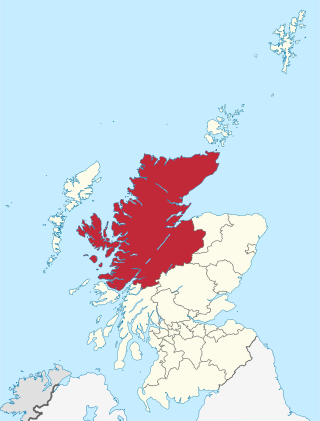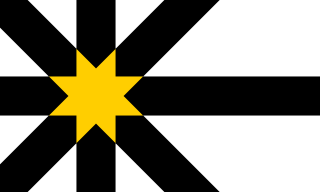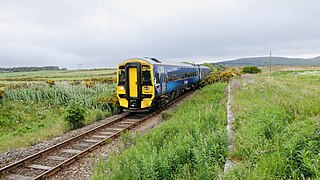
Highland is a council area in the Scottish Highlands and is the largest local government area in the United Kingdom. It was the 7th most populous council area in Scotland at the 2011 census. It shares borders with the council areas of Aberdeenshire, Argyll and Bute, Moray and Perth and Kinross. Their councils, and those of Angus and Stirling, also have areas of the Scottish Highlands within their administrative boundaries.

Sutherland is a historic county, registration county and lieutenancy area in the Highlands of Scotland. Its county town is Dornoch. Sutherland borders Caithness and Moray Firth to the east, Ross-shire and Cromartyshire to the south and the Atlantic to the north and west. Like its southern neighbour Ross-shire, Sutherland has some of the most dramatic scenery in Europe, especially on its western fringe where the mountains meet the sea. These include high sea cliffs and very old mountains composed of Precambrian and Cambrian rocks.

Caithness is a historic county, registration county and lieutenancy area of Scotland.

The Dornoch Firth is a firth on the east coast of Highland, in northern Scotland. It forms part of the boundary between Ross and Cromarty, to the south, and Sutherland, to the north. The firth is designated as a national scenic area, one of 40 such areas in Scotland. The national scenic area covers 15,782 ha in total, of which 4,240 ha is the marine area of the firth below low tide. A review of the national scenic areas by Scottish Natural Heritage in 2010 commented:
By comparison with other east coast firths the Dornoch Firth is narrow and sinuous, yet it exhibits within its compass a surprising variety of landscapes. It is enclosed by abrupt rounded granitic hills clad in heather moor and scree, their Gaelic names of cnoc, meall and creag giving the clue to their character. Their lower slopes are frequently wooded, oakwoods being a noticeable feature of the area, but with other deciduous and coniferous species represented in plantations which vary from the policy plantings of Skibo Castle to the pines of the Struie Forest.

Loch Shin is a loch in the Scottish North West Highlands. To the south is the small town of Lairg. The loch, the largest in Sutherland, runs from the north-west to the south-east and is 17 miles long.

The A836 is a major road entirely within the Highland area of Scotland. It is 122 miles (196 km) long and runs from Ross and Cromarty to Caithness, with the majority of its length in Sutherland. At 58.648°N where it passes through East Mey, it is the northernmost A-class road in mainland Great Britain.

The Far North Line is a rural railway line entirely within the Highland area of Scotland, extending from Inverness to Thurso and Wick. As the name suggests, it is the northernmost railway in the United Kingdom. The line is entirely single-track, with only passing loops at some intermediate stations allowing trains to pass each other. In common with other railway lines in the Highlands and northern Lowlands, it is not electrified and all trains are diesel-powered.

Bonar Bridge is a village on the north bank of the Kyle of Sutherland to the west and the Dornoch Firth to the east in the Parish of Creich in the Highland council area of Scotland.

Altnabreac railway station is a rural railway station in the Highland council area of Scotland. It serves the area of Altnabreac – a settlement in which the station itself is the main component – in the historic county of Caithness. The name Altnabreac derives from the Scots Gaelic Allt nam Breac, meaning "the stream of the trout".

Golspie is a village and parish in Sutherland, Highland, Scotland, which lies on the North Sea coast in the shadow of Ben Bhraggie. It has a population of around 1,350.

Invershin railway station is a railway station in the Highland council area of Scotland. The station is on the Far North Line, 61 miles 34 chains (98.9 km) from Inverness, between Culrain and Lairg. ScotRail, who manage the station, operate all services.

Lairg railway station is a railway station just south of the village of Lairg in the Highland council area of Scotland. The station is on the Far North Line, 66 miles 78 chains (107.8 km) from Inverness, between Invershin and Rogart. ScotRail, who manage the station, operate all services.

Georgemas Junction railway station is a railway station located in the Highland council area in the far north of Scotland. It serves several rural hamlets in the historic county of Caithness, including Georgemas, Roadside and Banniskirk. It is also the nearest station to the village of Halkirk, which lies approximately 1.6 miles (2.6 km) west of the station.

Thurso railway station is a railway station located in Thurso, in the Highland council area in the far north of Scotland. It serves the town and its surrounding areas, along with ferry services linking the mainland with Stromness on the Orkney Islands.

Wick railway station is a railway station located in Wick, in the Highland council area in the far north of Scotland. It serves the town of Wick and other surrounding areas in the historic county of Caithness, including Staxigoe, Papigoe and Haster. The station is the terminus of the Far North Line, 161 miles 36 chains from Inverness. It is managed by ScotRail, who operate all trains serving the station.
The Sutherland Railway was a railway company authorised in 1865 to build a line from Bonar Bridge station to Brora, a distance of nearly 33 miles, in the north of Scotland. This was to be continuation of a route from Inverness to Bonar Bridge that had been built by the Inverness and Ross-shire Railway; ultimately the line was extended to Thurso.
The Inverness and Ross-shire Railway was a Scottish railway company formed in 1860 to build a line from Inverness to Invergordon. It opened in 1862 as far as Dingwall and in 1863 to Invergordon. It was extended to a Bonar Bridge station in 1864. It provided the basis for later extensions that eventually reached Thurso, forming the Far North Line. The Dingwall and Skye Railway branched off at Dingwall to reach the Kyle of Lochalsh.

Achfrish is a hamlet situated towards the southeastern part of Loch Shin on the north side of the Loch in Highland, Scotland. It is also part of the wider community of Shinness which is made up of Achfrish, Tirryside, Achnairn, Colabul, Blairbuie and West Shinness. Achfrish is on the hill overlooking Loch Shin with views of Ben More Assynt to the West and Ben Klibreck to the North. Achfrish is approximately 4 miles from the larger village of Lairg which has a selection of shops, primary school and doctor's surgery. Secondary education is catered for in the coastal towns of Golspie and Dornoch.

The Dornoch Light Railway was a branch railway in Scotland that ran from The Mound on the Far North Line to Dornoch, the county town of Sutherland.
The Far North Line was built in several stages through sparsely populated and undulating terrain. Extending to 161 miles (259 km), it runs north from Inverness to Wick and Thurso in Caithness, and currently carries a regular passenger train service.



















